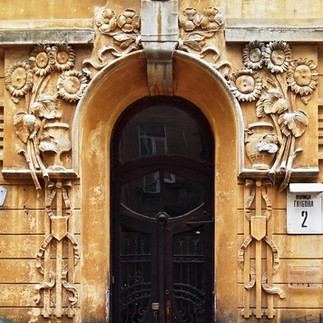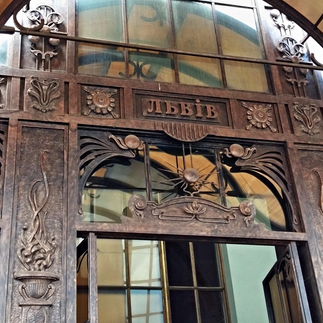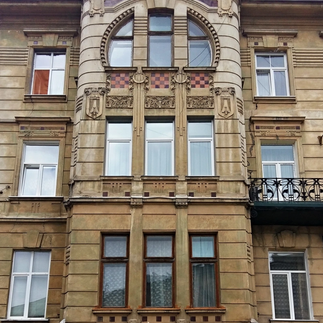- Henna

- Mar 17, 2022
- 5 min read
Updated: Mar 17, 2022
Just when one thought it couldn’t get any worse during the latest Covid-19 wave, the war in Ukraine broke out in all of its ugliness. And suddenly, everything one was doing and thinking till that point became so irrelevant and unimportant. I too was minding my normal daily business - finishing the second part of the wellness focused interior design blog post series to be exact - while I found myself struggling to concentrate, feeling utter sadness and anxiety about what I saw in the news. Quickly it became clear there would be no point in publishing anything related “how to wellness proof your home” while Ukrainians were getting bombed and killed in their homes and cities - just less than 1000 kilometres away where I was sitting in the comfort of my home. So, no wellness focused interior design part 2 today.
Instead, I want to tell you a design story from Ukraine: about the beautiful city of Lviv, the origins of its less known Art Nouveau buildings and about its own unique sub-style of Art Nouveau called Hutsul Secession.
The origins of Art Nouveau in Lviv
The modern day city of Lviv is located in the western part of Ukraine about 70 kilometres from the Polish border. It is Ukraine’s 7th most populated city with approximately 720.000 inhabitants. The city has a long and vivid history: It was originally founded already during the 13th century, and has since been part of Poland, Austro-Hungarian empire and Soviet Union before Ukraine’s independence in 1991.
In the beginning of the 20th century, when the western parts of Ukraine and southern Poland were part of the Habsburg empire (they formed a multinational kingdom called Galicia and Lodomeria), Art Nouveau architectural style reached Lviv. Although Galicia and Lodomeria was a fairly remote region of the Austro-Hungarian empire, its capital Lviv was the fifth largest city of the empire after Vienna, Budapest, Prague, and Trieste. During this time, Lviv was a major center of Polish, Jewish and Ukrainian culture. Art Nouveau style architecture developed in Lviv mainly due to the influence of Vienna and especially the Otto Wagner architectural school.
Art Nouveau (also often called Secession, Belle Époque, Jugendstil, Stile Liberty, Modernisme in Europe) was a new decorative style of art and architecture in Europe (and United States) during 1890-1914. This period coincided with a sharp increase in the national consciousness of various cultures and minorities in Europe. In architecture Art Nouveau resulted in a transitional, distinct style which purposefully cut ties with the past and introduced the early ideas of the modernism as well as strong sense of national flavours and symbolism into buildings. In Art Nouveau buildings the synthesis of ornament and structure was always very important; they were inspired by many natural forms, had sense of dynamism and movement, asymmetry and used modern materials (iron, glass, ceramics among others) to create unusual forms and open spaces. After 1914 Art Nouveau was already regarded old-fashioned and was widely abandoned as a distinct decorative style in Europe.
The Hutsul Secession and its Masterminds
Due to the strong influence of Viennese Secession in Galicia and Lodomeria, many local architects initially imitated its style in their buildings. This was especially true in the major cities in the Eastern part of the kingdom. However, in the Western part of Galicia and Lodomeria - namely in Lviv - a unique architectural style known as the Hutsul Secession was born during 1890-1900. This new sub-style of Art Nouveau drew its influences not only from the Viennese Secession, but also from the folk art and architecture of the Carpathian highlanders, especially the Hutsuls. The Hutsul Secession was a first attempt to create Ukrainian national style of architecture. Compared to other European Art Nouveau cities (Paris, Brussels, Vienna or Glasgow), Art Nouveau in Ukraine however remained much more conservative.
The folk element is what distinguishes the Hutsul Secession from all the other secessionist styles present in today’s Ukraine. The most recognisable features of this style are the roofs with steep slopes and bold contours (sometimes with towers), reminiscent of the wooden churches of the Carpathians, and folk ornaments around doors and windows, most often in the form of bands and panels of ceramic tiles showing patterns and colours of traditional art. Lviv and Ivano-Frankivsk (Stanislaviv) were the main centres of Hutsul style, although few examples of it could be found in other places as well.
Undoubtedly, the most important architect of Lviv’s Art Nouveau history, and the key figure behind the Hutsul Secession was Ivan Levynskyi (1851-1919). The most outstanding secessionist buildings in Lviv were designed by his architectural firm which employed also other great architects like Tadeusz Obmiński (1874-1932) and Oleksandr Lushpynskyi (1878-1943). Among the most notable designs of Ivan Levynskyi’s firm were the Chamber of Commerce and Industry, the George Hotel, the Dnister Insurance Company Building, and the ensemble of Bohomoltsia street. Levynskyi and his team also designed and built hospitals and a sanatoriums in Lviv. In addition to being an architect, Levynskyi also ran a ceramic factory, which produced the majolica tiles that decorate the many façades of Art Nouveau buildings of the city.
Long ignored but never forgotten
According to experts there are still today at least 150 Art Nouveau buildings remaining in Lviv (more than 500 in whole Ukraine). Because of its strong Polish and Austro-Hungarian history, Lviv has a fascinating Central European flair on its streets and is often regarded as one of the most beautiful cities in Eastern Europe. No wonder, Lviv has often been called the capital of Ukrainian culture.
Although Lviv nowadays has the Unesco World Heritage status, it seems however that its Art Nouveau treasures are still not that well-known to rest of the world, and that so far mostly only art and architecture historians have written about its buildings - trying to highlight their cultural importance. Come to think of it, it is also quite amazing, how only about 100 artists, architects and designers managed to create this new Ukrainian Modern style in Lviv in such a short time - yet most of their identities and legacies to this day remain much of mystery and not well studied. Sadly, the main reason for this “collective forgetfulness” is, that during the Stalinist regime the Ukrainian Art Nouveau was branded as “a decadent style”, it was actively ignored/suppressed, and many of the architects and artists of Lviv were either arrested or sent to concentration camps. Unfortunately, only handful of them managed to survive by fleeing abroad.
I hope knowing a bit more about Lviv (other than the current news) has been as eye-opening and surprising to you as it was to me. As I’m finishing this, it seems that unfortunately the war is now approaching also the city of Lviv. I hope there comes a time in a not too distant future, when we could put this insanity behind us, and recognise again our common humanity along with the beauty and richness of our cultural differences.
(Images by Jürgen Järvik via grandeflanerie.com)
(Sources: forgottengalicia.com; grandeflanerie.com; Lviv Interactive)
I'm an interior designer who writes stories about interior design inspirations, ideas, furniture and architecture from around the world. My mission is to entertain you during your morning coffee - to show you how the world is full of interesting design stories - and to make you look your own surroundings differently. You are part of a story! Welcome to be part of Design Stories of Onni Interiors!






















Wonderful!